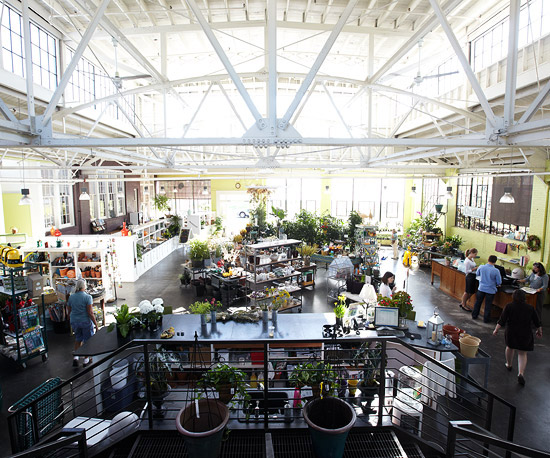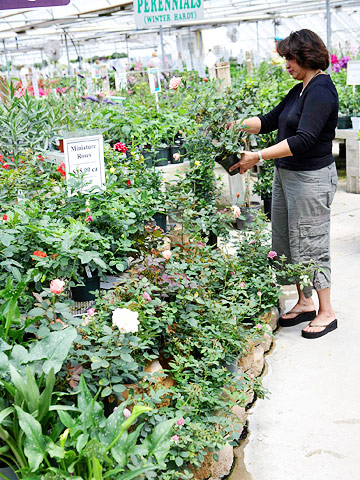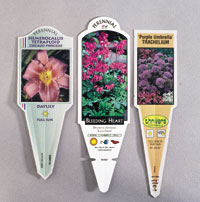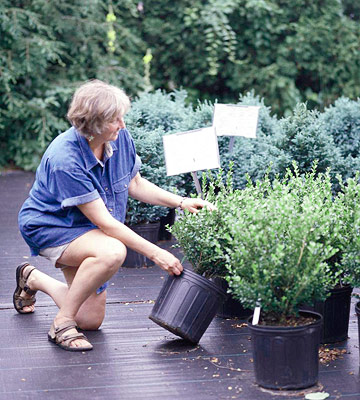






Barbara Pierson knows nursery garden plants. As nursery manager at White Flower Farm in Litchfield, Connecticut, she is surrounded by all things growing, all day long, and she helps people from across the United States select plants for their landscapes. Here's what she's learned about shopping for nursery plants to give your landscape a healthy, beautiful start.
BHG: You get all kinds of questions about all kinds of nursery garden plants every day. What's the No. 1 secret you share with people shopping for nursery plants?
Pierson: The No. 1 shopping secret is to read the plant labels: exposure, hardiness Zone, mature height and width. The right plant in the right location will perform for you and be less susceptible to insects and disease.

The second shopping secret is know your garden. Are you planting a sunny spot or the shady side of the house? Would you like year-round interest from an evergreen or color in summer from a coneflower? Always have a plan or at least an area in mind when shopping for nursery garden plants. Know your site and your hardiness Zone.
The best shopping secret for a beginner looking for nursery garden plants is to start small. Don't try to plant a large area if you are new to gardening; you will become overwhelmed. Try a shrub as a focal point with easy-care perennials such as Salvia 'May Night' and Rudbeckia 'Goldsturm'.
For the experienced gardener, try a new variety of a plant you love, such as roses -- there are so many new colors and types to choose from. Every year, breeders introduce new varieties of shrubs and perennials, so there are always plenty of exciting plants.
Learn more about new rose varieties!
BHG: We've all gone to a nursery and gotten overwhelmed or picked out some nursery garden plants that won't work well in our landscape. Besides site specifics, what else should people think about before selecting plants at a nursery?
Pierson: If you're not sure, ask questions. Garden center staff and online retailers have all kinds of cultural information for you. Let them know you have had poor results and they might be able to pinpoint what the problem was. Let them guide you through the process; everyone loves to talk about plants.

BHG: So you have all the information in hand -- plan, nursery garden plant ideas. How do you use that at the nursery?
Pierson: You start with the nursery garden plant label. Everything you need to know about the plant -- sun and shade needs, soil conditions, moisture, bloom time, mature growth size -- is on that plant label. Using the plants' labels and your plan together is a great way to choose the best nursery plants. Take your time and figure things out so you come home with plants that have staggering bloom times, for example. I make the same mistakes as other people. For example, I get really excited and want to have all these plants, so I put too many plants in and my garden gets overgrown quickly, which can lead to disease problems. Reading the labels helps prevent issues such as that.
BHG: Say you need a purple coneflower and you have two pots of it side by side at the nursery. What should you do?
Pierson: Start by looking at the roots. You should see some roots coming out of the drainage holes; that's a clue that the nursery garden plant is rooted, and roots are more important than top growth. If the plant is not rooted, it is less mature and will not transplant as well. If you can't see roots, gently pull the plant out of the pot to get a good look. Now, here's an easy-to-remember tip for choosing nursery plants: Some plants can be pot-bound if they have been sitting in the pot for a very long time. If you see roots girdling the pot and suspect the plant has been sitting in it for a long time, ask the nursery staff how old the plant is.
BHG: Is it a good or bad idea to buy a nursery garden plant that's flowering?
Pierson: Generally, a plant that hasn't been forced into flower does better than a plant that has been forced into flower. A plant that has a lot of foliage is better than a spindly plant with a flower on top.

BHG: How does a gardener judge the health of shrubs and trees?
Pierson: Make sure the tree or shrub is very full, with lots of stems. It should be rooted, which is particularly important for evergreens, and have lots of foliage on top. Then look for obvious signs of stress -- brown leaves, spotted foliage, brown growing points, a top that doesn't look healthy. Those are your cues that a nursery plant hasn't been taken care of.
BHG: If a gardener finds a nursery garden plant they really like, should they start with just one?
Pierson: For perennials and annuals, it's always good to plant in groups of at least three. If you plant just one of too many different things, it looks funny. But drifts of color make a nice impact. So another shopping secret is that I would buy at least three of a single type of nursery plant.
BHG: Any last words of advice?
Pierson: It is overwhelming to make those choices, but there are a lot of resources now, and the secrets for shopping for nursery garden plants are things people can understand and remember. Do your research beforehand. Pick up a catalog, look at your landscape, and don't be afraid to ask questions. Plants change all the time, and nursery people are there to help. If you do your planning before going to the nursery, it will pay off later.
Copyright © www.100flowers.win Botanic Garden All Rights Reserved